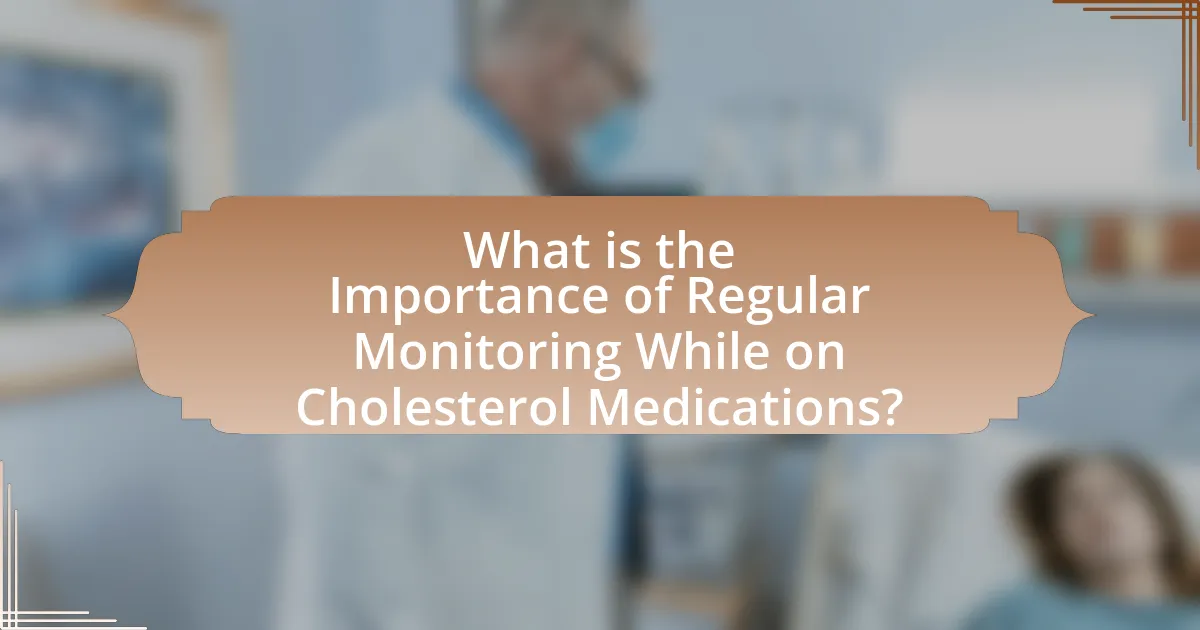The article emphasizes the critical role of regular monitoring for individuals on cholesterol medications, highlighting its importance in ensuring treatment effectiveness and minimizing side effects. It discusses the necessity of consistent lipid level assessments, the risks associated with inadequate monitoring, and how regular check-ups can lead to improved cardiovascular health outcomes. Key components of effective monitoring, common tests used, and the frequency of cholesterol level checks are outlined, along with the significance of patient education and technology in enhancing adherence to monitoring routines. The article also addresses challenges patients face in maintaining monitoring schedules and offers best practices for healthcare providers to support patients in overcoming these barriers.

What is the Importance of Regular Monitoring While on Cholesterol Medications?
Regular monitoring while on cholesterol medications is crucial for ensuring the effectiveness of treatment and minimizing potential side effects. This practice allows healthcare providers to assess lipid levels, adjust dosages, and evaluate the patient’s overall cardiovascular risk. Studies indicate that consistent monitoring can lead to better management of cholesterol levels, reducing the risk of heart disease and stroke. For instance, the American Heart Association recommends regular lipid panel tests to track changes and make informed decisions about medication adjustments.
Why is monitoring necessary for individuals on cholesterol medications?
Monitoring is necessary for individuals on cholesterol medications to ensure the effectiveness of the treatment and to minimize potential side effects. Regular monitoring allows healthcare providers to assess lipid levels, adjust dosages, and identify any adverse reactions, which is crucial since approximately 10-15% of patients may experience side effects such as muscle pain or liver enzyme elevation. Furthermore, studies indicate that consistent monitoring can lead to better adherence to treatment plans and improved cardiovascular outcomes, reinforcing the importance of regular check-ups in managing cholesterol levels effectively.
What risks are associated with not monitoring cholesterol levels?
Not monitoring cholesterol levels increases the risk of cardiovascular diseases, including heart attacks and strokes. Elevated cholesterol can lead to the buildup of plaques in arteries, a condition known as atherosclerosis, which narrows blood vessels and restricts blood flow. According to the American Heart Association, high levels of low-density lipoprotein (LDL) cholesterol are a significant risk factor for coronary artery disease, which affects millions of individuals globally. Regular monitoring allows for timely interventions, such as lifestyle changes or medication adjustments, to manage cholesterol levels effectively and reduce these health risks.
How can monitoring improve treatment outcomes?
Monitoring can improve treatment outcomes by enabling healthcare providers to assess the effectiveness of cholesterol medications and make timely adjustments. Regular monitoring of cholesterol levels allows for the identification of whether a patient is reaching their target lipid levels, which is crucial for reducing cardiovascular risks. Studies indicate that patients who undergo consistent monitoring are more likely to adhere to their treatment plans and achieve better health outcomes, as evidenced by a 2019 study published in the Journal of the American College of Cardiology, which found that patients with regular follow-ups had a 30% higher likelihood of reaching their cholesterol goals compared to those without monitoring.
What are the key components of effective monitoring?
The key components of effective monitoring include clear objectives, consistent data collection, timely analysis, and actionable feedback. Clear objectives ensure that monitoring efforts are aligned with specific health goals, such as managing cholesterol levels. Consistent data collection involves regularly measuring relevant health indicators, such as lipid profiles, to track progress. Timely analysis allows for quick interpretation of data, enabling healthcare providers to make informed decisions. Actionable feedback provides patients with insights and recommendations based on their monitoring results, facilitating better adherence to cholesterol medications and lifestyle changes. These components collectively enhance the effectiveness of monitoring in managing cholesterol levels and improving patient outcomes.
What tests are commonly used to monitor cholesterol levels?
The tests commonly used to monitor cholesterol levels are the lipid panel and the lipid profile. These tests measure total cholesterol, low-density lipoprotein (LDL) cholesterol, high-density lipoprotein (HDL) cholesterol, and triglycerides. The lipid panel is a standard blood test that provides a comprehensive overview of an individual’s cholesterol levels, which is crucial for assessing cardiovascular health and the effectiveness of cholesterol medications. Regular monitoring through these tests helps healthcare providers make informed decisions regarding treatment adjustments and lifestyle recommendations.
How often should cholesterol levels be checked while on medication?
Cholesterol levels should be checked every 3 to 12 months while on medication, depending on individual risk factors and treatment goals. Regular monitoring is essential to assess the effectiveness of the medication and make necessary adjustments. The American Heart Association recommends that patients on statin therapy have their cholesterol levels evaluated at least once a year, while those with higher cardiovascular risk may require more frequent assessments to ensure optimal management of their cholesterol levels.
What role does patient education play in monitoring?
Patient education plays a crucial role in monitoring by empowering individuals to understand their health conditions and the importance of adherence to treatment plans. Educated patients are more likely to engage in self-monitoring practices, such as tracking their cholesterol levels and recognizing symptoms that may require medical attention. Research indicates that patients who receive comprehensive education about their medications and health status demonstrate improved adherence rates, which directly correlates with better health outcomes. For instance, a study published in the Journal of Clinical Lipidology found that patients who participated in educational programs showed a significant reduction in LDL cholesterol levels compared to those who did not receive such education. This highlights the effectiveness of patient education in enhancing monitoring practices and ultimately improving the management of cholesterol levels.
How can patients be empowered to monitor their own health?
Patients can be empowered to monitor their own health by utilizing technology such as mobile health applications and wearable devices that track vital signs and medication adherence. These tools provide real-time data, enabling patients to understand their health status and make informed decisions. Research indicates that patients who engage with digital health tools report higher levels of satisfaction and improved health outcomes, as they can actively participate in their care management. For instance, a study published in the Journal of Medical Internet Research found that patients using mobile health applications for chronic disease management experienced better adherence to treatment plans and improved health metrics.
What resources are available for patient education on cholesterol management?
Resources available for patient education on cholesterol management include the American Heart Association, which provides guidelines and educational materials on cholesterol levels and heart health. The National Lipid Association offers resources such as patient brochures and online tools to help individuals understand their cholesterol and manage it effectively. Additionally, the Centers for Disease Control and Prevention (CDC) provides information on cholesterol management through its website, including tips for lifestyle changes and dietary recommendations. These organizations are credible sources that offer evidence-based information to support patients in managing their cholesterol levels effectively.
How does regular monitoring impact overall health management?
Regular monitoring significantly enhances overall health management by enabling timely adjustments to treatment plans based on individual responses. This proactive approach allows healthcare providers to track cholesterol levels, assess medication efficacy, and identify potential side effects early. For instance, studies indicate that patients who undergo regular lipid panel tests while on cholesterol medications are more likely to achieve target cholesterol levels, thereby reducing the risk of cardiovascular events. This evidence underscores the critical role of consistent monitoring in optimizing health outcomes and ensuring effective management of cholesterol-related conditions.
What are the long-term benefits of consistent cholesterol monitoring?
Consistent cholesterol monitoring leads to improved cardiovascular health and reduced risk of heart disease. By regularly tracking cholesterol levels, individuals can identify trends and make timely lifestyle or medication adjustments, which is crucial for maintaining optimal lipid profiles. Research indicates that patients who monitor their cholesterol consistently are more likely to achieve target levels, thereby decreasing the incidence of heart attacks and strokes. For instance, a study published in the Journal of the American College of Cardiology found that regular monitoring significantly correlates with better adherence to treatment plans and improved overall health outcomes.
How does monitoring influence lifestyle changes and adherence to medication?
Monitoring significantly enhances lifestyle changes and adherence to medication by providing individuals with real-time feedback on their health status. This feedback encourages patients to make informed decisions regarding their diet, exercise, and medication compliance. For instance, studies have shown that patients who engage in regular monitoring of their cholesterol levels are more likely to adopt healthier eating habits and maintain consistent physical activity, leading to improved overall health outcomes. Additionally, a systematic review published in the Journal of the American College of Cardiology found that patients who received regular monitoring and feedback on their cholesterol levels demonstrated a 20% increase in adherence to prescribed statin medications compared to those who did not receive such monitoring. This evidence underscores the critical role of monitoring in promoting both lifestyle modifications and medication adherence.
What challenges do patients face in regular monitoring?
Patients face several challenges in regular monitoring while on cholesterol medications, including adherence to medication schedules, access to healthcare resources, and understanding of monitoring requirements. Adherence issues arise as patients may forget doses or struggle with the routine, leading to inconsistent monitoring of cholesterol levels. Access to healthcare resources can be limited due to financial constraints, lack of transportation, or insufficient availability of healthcare providers, which can hinder regular check-ups and lab tests. Additionally, patients often lack a clear understanding of the importance of monitoring their cholesterol levels and the specific parameters they need to track, which can result in inadequate self-management of their health. These challenges can ultimately affect the effectiveness of cholesterol management and increase the risk of cardiovascular events.
What barriers might prevent patients from adhering to monitoring schedules?
Barriers that might prevent patients from adhering to monitoring schedules include lack of understanding of the importance of monitoring, financial constraints, and logistical challenges. Many patients may not fully grasp how regular monitoring impacts their health outcomes, leading to decreased motivation to follow through. Financial constraints, such as the cost of tests or transportation to healthcare facilities, can also hinder adherence. Additionally, logistical challenges, including scheduling conflicts or difficulty accessing healthcare services, further complicate patients’ ability to maintain consistent monitoring. These factors collectively contribute to non-adherence, as evidenced by studies indicating that patient education and accessibility significantly influence monitoring compliance.
How can healthcare providers support patients in overcoming these challenges?
Healthcare providers can support patients in overcoming challenges related to cholesterol medications by implementing regular monitoring protocols and providing education on medication adherence. Regular monitoring allows healthcare providers to assess the effectiveness of the treatment and make necessary adjustments, which is crucial since studies show that consistent monitoring can lead to better cholesterol management and reduced cardiovascular risks. Additionally, educating patients about the importance of adherence to their medication regimen can improve outcomes; for instance, research indicates that patients who understand their treatment plan are more likely to follow it, leading to a 50% increase in adherence rates.
What best practices can enhance the monitoring process?
Implementing a structured monitoring schedule enhances the monitoring process for patients on cholesterol medications. Regularly scheduled check-ups, typically every 3 to 6 months, allow healthcare providers to assess lipid levels and adjust medications as necessary, ensuring optimal treatment efficacy. Additionally, utilizing patient self-monitoring tools, such as home cholesterol testing kits, empowers patients to take an active role in their health management. Research indicates that patients who engage in self-monitoring are more likely to adhere to their medication regimen, leading to improved outcomes (American Heart Association, 2021). Furthermore, maintaining clear communication between patients and healthcare providers fosters a collaborative approach, enabling timely interventions and personalized care adjustments.
How can technology aid in the monitoring of cholesterol levels?
Technology aids in the monitoring of cholesterol levels through the use of digital health tools such as mobile applications, wearable devices, and telehealth services. These tools enable individuals to track their cholesterol levels in real-time, receive reminders for medication adherence, and access personalized health insights. For instance, mobile apps can sync with blood testing devices to provide instant feedback on cholesterol readings, while wearables can monitor related health metrics like heart rate and activity levels, contributing to a comprehensive health profile. Studies have shown that patients using digital health interventions demonstrate improved adherence to cholesterol management protocols, leading to better overall health outcomes.
What tips can help patients stay consistent with their monitoring routines?
Patients can stay consistent with their monitoring routines by establishing a structured schedule for their checks. This can be achieved by setting reminders on their phones or using a calendar to mark specific days for monitoring. Research indicates that individuals who use reminders are 30% more likely to adhere to their health routines. Additionally, keeping a log of results can help patients track their progress and identify patterns, which reinforces the importance of regular monitoring. Engaging with healthcare providers for regular follow-ups also enhances accountability, as studies show that patients who maintain communication with their doctors are more likely to stay consistent with their health management.










